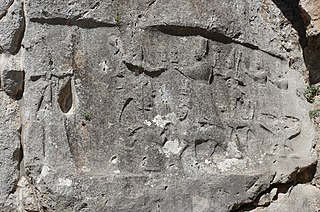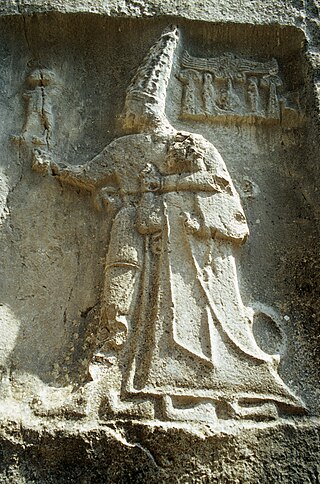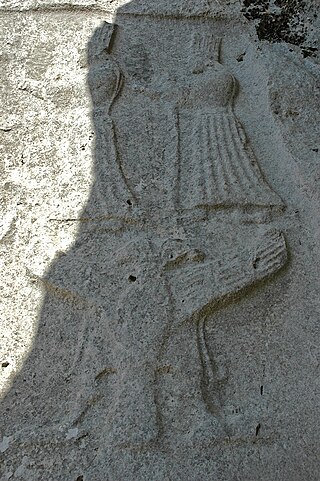
Teshub was the Hurrian weather god, as well as the head of the Hurrian pantheon. The etymology of his name is uncertain, though it is agreed it can be classified as linguistically Hurrian. Both phonetic and logographic writings are attested. As a deity associated with the weather, Teshub could be portrayed both as destructive and protective. Individual weather phenomena, including winds, lightning, thunder and rain, could be described as his weapons. He was also believed to enable the growth of vegetation and create rivers and springs. His high position in Hurrian religion reflected the widespread importance of weather gods in northern Mesopotamia and nearby areas, where in contrast with the south agriculture relied primarily on rainfall rather than irrigation. It was believed that his authority extended to both mortal and other gods, both on earth and in heaven. However, the sea and the underworld were not under his control. Depictions of Teshub are rare, though it is agreed he was typically portrayed as an armed, bearded figure, sometimes holding a bundle of lightning. One such example is known from Yazılıkaya. In some cases, he was depicted driving in a chariot drawn by two sacred bulls.

Šarruma, also romanized as Šarrumma or Sharruma, was a Hurrian god. He could be depicted in both anthropomorphic form, sometimes riding on the back of a leopard, and in the theriomorphic form as a bull. His character is not fully understood, though it is known that he could function as a mountain god. He was regarded as a son of Ḫepat and Teshub. He was also linked to various moon deities. Additionally, the only mythological text he appears in addresses him as a messenger (sukkalu) of Kumarbi. He was worshiped by Hurrians in southeastern Anatolia and northern Syria, for example in Kummanni and Lawazantiya in Kizzuwatna. From this kingdom he was introduced to the Hittite pantheon as well. Hittite influence in turn resulted in his introduction to cities such as Aleppo, Emar and Ugarit. He was also venerated in Luwian religion in the first millennium BCE, with theophoric names invoking him attested from as late as the Hellenistic period in Cilicia and Lycia.

Ḫepat was a goddess associated with Aleppo, originally worshiped in the north of modern Syria in the third millennium BCE. Her name is often presumed to be either a feminine nisba referring to her connection to this city, or alternatively a derivative of the root ḫbb, "to love". Her best attested role is that of the spouse of various weather gods. She was already associated with Adad in Ebla and Aleppo in the third millennium BCE, and in later times they are attested as a couple in cities such as Alalakh and Emar. In Hurrian religion she instead came to be linked with Teshub, which in the first millennium BCE led to the development of a tradition in which she was the spouse of his Luwian counterpart Tarḫunz. Associations between her and numerous other deities are described in Hurrian ritual texts, where she heads her own kaluti, a type of offering lists dedicated to the circle of a specific deity. She commonly appears in them alongside her children, Šarruma, Allanzu and Kunzišalli. Her divine attendant was the goddess Takitu. In Hittite sources, she could sometimes be recognized as the counterpart of the Sun goddess of Arinna, though their respective roles were distinct and most likely this theological conception only had limited recognition. In Ugarit the local goddess Pidray could be considered analogous to her instead.

Kušuḫ, also known under the name Umbu, was the god of the moon in Hurrian pantheon. He is attested in cuneiform texts from many sites, from Hattusa in modern Turkey, through Ugarit, Alalakh, Mari and other locations in Syria, to Nuzi, located near modern Kirkuk in Iraq, but known sources do not indicate that he was associated with a single city. His name might be derived from the toponym Kuzina, possibly the Hurrian name of Harran, a city in Upper Mesopotamia, but both this etymology and identification of this sparsely attested place name remain uncertain. He was a popular, commonly worshiped god, and many theophoric names invoking him are known. In addition to serving as a divine representation of the moon, he was also associated with oaths, oracles and pregnancy. Some aspects of his character were likely influenced by his Mesopotamian counterpart Sin, while he in turn was an influence on the Ugaritic god Yarikh and Luwian Arma.
Ḫašamili was a god worshiped in Bronze Age Anatolia. He originated in religious beliefs of the Hattians, and later came to be incorporated into the Hittite, Palaic and Luwian pantheons. He was regarded as a protective household deity, and was additionally associated with metalworking. He appears in the myth of Ḫaḫḫima, but his role in it is not fully understood.

Nikkal or Nikkal-wa-Ib was a goddess worshiped in various areas of the ancient Near East west of Mesopotamia. She was derived from the Mesopotamian goddess Ningal, and like her forerunner was regarded as the spouse of a moon god, whose precise identity varied between locations. While well attested in Hurrian and Hittite sources, as well as in Ugarit, she is largely absent from documents from the western part of ancient Syria.
Ḫapantali, also known as Ḫapantaliya, was a Luwian goddess who functioned as a divine shepherd. She was also incorporated into Hattian and Hittite beliefs. She is first attested in the Old Assyrian period, and later continued to be worshiped until the fall of the Hittite Empire. She appears in a variety of texts, including descriptions of festivals, treaties, and myths. While in ritual texts she was often linked with Inar, in mythological context she instead could be designated as a helper of Kamrušepa or her husband Tiwad.
Maliya was a goddess worshiped by Hittites in the Bronze Age. She was most likely a deified river in origin, but she was also associated with gardens and with artisanship, specifically with leatherworking and carpentry. The oldest attestations of her have been identified in the Old Assyrian texts from Kanesh. This city continued to be associated with her in later tradition, though she was also worshiped in Hattusa and elsewhere in the Hittite Empire. She is also present in texts originating in Kizzuwatna, which indicate she had a temple in Kummanni, where she was worshiped alongside various Hurrian deities.

Luwian religion was the religious and mythological beliefs and practices of the Luwians, an Indo-European people of Asia Minor, which is detectable from the Bronze Age until the early Roman empire. It was strongly affected by foreign influence in all periods and it is not possible to clearly separate it from neighbouring cultures, particularly Syrian and Hurrian religion. The Indo-European element in the Luwian religion was stronger than in the neighbouring Hittite religion.

Kubaba was a goddess of uncertain origin worshiped in ancient Syria. Despite the similarity of her name to these of legendary queen Kubaba of Kish and Phrygian Cybele, she is considered a distinct figure from them both. Her character is poorly known. Multiple local traditions associating her with other deities existed, and they cannot necessarily be harmonized with each other. She is first documented in texts from Kanesh and Alalakh, though her main cult center was Carchemish. She was among the deities worshiped in northern Syria who were incorporated into Hurrian religion, and in Hurrian context she occurs in some of the Ugaritic texts. She was also incorporated into Hittite religion through Hurrian intermediaties. In the first millennium BCE she was worshiped by Luwians, Arameans and Lydians, and references to her can be found in a number of Greek texts.
Adamma was a goddess worshiped in Ebla in the third millennium BCE, later also documented in Hurrian sources and in Emar. The origin and meaning of her name remain a matter of debate among researchers. It is commonly assumed that it originated in one of the Semitic languages and that it can be compared to Hebrew ʾădāmâ, "soil" or "earth". An alternate view is that it belongs to a linguistic substrate at some point spoken in part of modern Syria. Hurrian origin has been proposed as well, but is considered implausible. In Ebla, Adamma received sacrificial sheep on behalf of the royal palace. She also had clergy of her own, as evidenced by references to a dam-dingir priestess in her service. Eblaite texts indicate she was also venerated in Hadani and Tunip. She was locally regarded as the spouse of Resheph, though the connection between them is not attested in later sources. After the fall of Ebla, she was incorporated into Hurrian religion, and in this context appears in Hittite and Ugaritic sources as well, often forming a pair with Kubaba. Furthermore, she was worshiped in Emar, where under the name Adammatera she might have been perceived as a deity associated with storage areas and the underworld. It is also possible that the goddess Admu known from Mari and from the Mesopotamian god list An = Anum was the same deity.

Nabarbi or Nawarni was a Hurrian goddess possibly associated with pastures. She was one of the major deities in Hurrian religion, and was chiefly worshiped in the proximity of the river Khabur, especially in Taite. It has been proposed that she was associated with the goddess Belet Nagar, linked to the Upper Mesopotamian city of Nagar. In addition to being venerated in Hurrian religion, she was also incorporated into the beliefs of the Hittites and into the local pantheon of Emar. She also continued to be worshiped in Taite in the Neo-Assyrian period, as attested in a text from the reign of Ashurbanipal, where she is one of the deities invoked to bless the king.
Iyarri, also known as Yarri, was a god worshiped by Hittites and Luwians in Anatolia in the Bronze Age. He was associated with plague and war, and was portrayed as an archer whose arrows inflicted people with illnesses. While it is generally assumed that Iyarri was male, a female form of this deity is mentioned in a single text. It has been proposed that Iyarri might have developed from the Mesopotamian god Erra, or that he was influenced by him. A different proposal considers his name a cognate of that of Greek Ares, though the evidence in favor of this view is not conclusive.
Anna was the main deity of Kanesh, an Anatolian city which in the Old Assyrian period served as an Assyrian trading colony. Multiple possibilities regarding her origin have been considered by researchers. A temple, festivals and clergy dedicated to her are attested in texts from her city, and in contracts she appears alongside the Assyrian god Ashur. At some point her position declined, and an unidentified weather god became the main local deity instead. It is nonetheless assumed that she continued to be worshiped later on by Hittites and Luwians. It has also been proposed that a deity from Emar can be identified with her, though not all researchers share this view.

Allanzu, later known under the name Alasuwa, was a Hurrian goddess regarded as a daughter of Ḫepat. She was described as a youthful deity and in known texts often appears in association with her mother and siblings. She was also worshiped by Hittites and Luwians.
Taru was a weather god worshiped in ancient Anatolia by Hattians. He was associated with the bull, and could be depicted in the form of this animal. It is presumed that the names of the Hittite and Luwian weather gods, Tarḫunna and Tarḫunz, while etymologically Indo-European, were meant to resemble Taru's as a result of Hattian cultural influence on other cultures of the region.
Tiyaz or Tiyad was the sun god of the Palaians, regarded as the third most important deity in their pantheon. He was also incorporated into Hittite religion. He appears in a ritual written in Palaic, though presumed to belong to a Hittite corpus, in which he is implored to anoint the king. After the fall of the Hittite Empire, he might have been worshiped by Phrygians.
Šulinkatte was a Hittite god of Hattian origin. He was regarded as a war deity. Additionally, he could fulfill the role of a protector of palaces and houses. In the local tradition of Nerik, he was regarded as the father of the weather god of Nerik. He first appears in texts dated to the fifteenth or fourteenth century BCE. His main cult center was the sparsely attested city Tamarmara, but he was also worshiped elsewhere in ancient Anatolia, for example in Hattusa and Nerik. Fragments of a Hattic song celebrating him are also known.
Iyaya was a Hittite and Luwian goddess. Her functions remain uncertain, though it has been suggested she was associated with water or more broadly with nature. She might have been associated with the god Šanta, though the available evidence is limited. Her main cult centers were Lapana and Tiura, though she was also worshiped in other cities.
Tenu was a Hurrian god regarded as a divine attendant (sukkal) of Teshub. He might have originated in a local tradition typical for Aleppo. He appears in a number of Hurrian offering lists (kaluti), as well as Hittite and Emariote texts.











